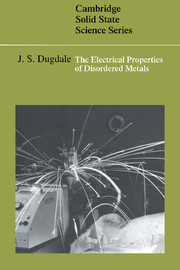Book contents
- Frontmatter
- Contents
- Preface
- 1 Context and content
- 2 Production and structure of metallic glasses
- 3 Electron transport in metals: introduction to conventional theory
- 4 Scattering
- 5 Simple liquid metals: Ziman theory
- 6 Phonons in disordered systems
- 7 Interactions and quasi-particles
- 8 Transition metals and alloys
- 9 The Hall coefficient of metallic glasses
- 10 Magnetoresistance
- 11 Electrical conductivity of metallic glasses: weak localisation
- 12 The interaction effect or Coulomb anomaly
- 13 The effect of the Coulomb interaction on conductivity
- 14 Influence of a magnetic field on the enhanced interaction effect
- 15 The thermopower of metals and alloys
- 16 Comparison with experiment
- Appendices
- Notes
- References
- Index
8 - Transition metals and alloys
Published online by Cambridge University Press: 21 January 2010
- Frontmatter
- Contents
- Preface
- 1 Context and content
- 2 Production and structure of metallic glasses
- 3 Electron transport in metals: introduction to conventional theory
- 4 Scattering
- 5 Simple liquid metals: Ziman theory
- 6 Phonons in disordered systems
- 7 Interactions and quasi-particles
- 8 Transition metals and alloys
- 9 The Hall coefficient of metallic glasses
- 10 Magnetoresistance
- 11 Electrical conductivity of metallic glasses: weak localisation
- 12 The interaction effect or Coulomb anomaly
- 13 The effect of the Coulomb interaction on conductivity
- 14 Influence of a magnetic field on the enhanced interaction effect
- 15 The thermopower of metals and alloys
- 16 Comparison with experiment
- Appendices
- Notes
- References
- Index
Summary
The obvious success of the Ziman theory does not extend to the liquid transition metals and, as we shall see in the next chapter, the Hall coefficient of a number of glasses containing a substantial proportion of transition metal is positive, thereby posing a powerful challenge to conventional theories. Before we try to compare theory and experiment, however, let us look at some of the important properties of transition metals and their alloys, in both crystalline and glassy forms.
Crystalline transition metals
A transition metal is one whose atoms have incomplete d-shells, such as iron or tungsten. Typically in the free atom there are also s electrons from a higher electron shell, for example, there may be two 3d-electrons and one 4s. In the solid state the wavefunctions overlap and the single states of the free atom spread out into bands whose electrons can therefore take part in the conduction process. The s-levels broaden much more than the d-levels as the atoms get closer. This is because the s-electrons come from the outer reaches of the atom with wavefunctions that overlap strongly with those of their neighbours in the solid. The d-electrons by contrast are more tightly bound within the atom and so in the solid form a much narrower band whose electrons tend to have much lower velocities.
- Type
- Chapter
- Information
- The Electrical Properties of Disordered Metals , pp. 71 - 80Publisher: Cambridge University PressPrint publication year: 1995



